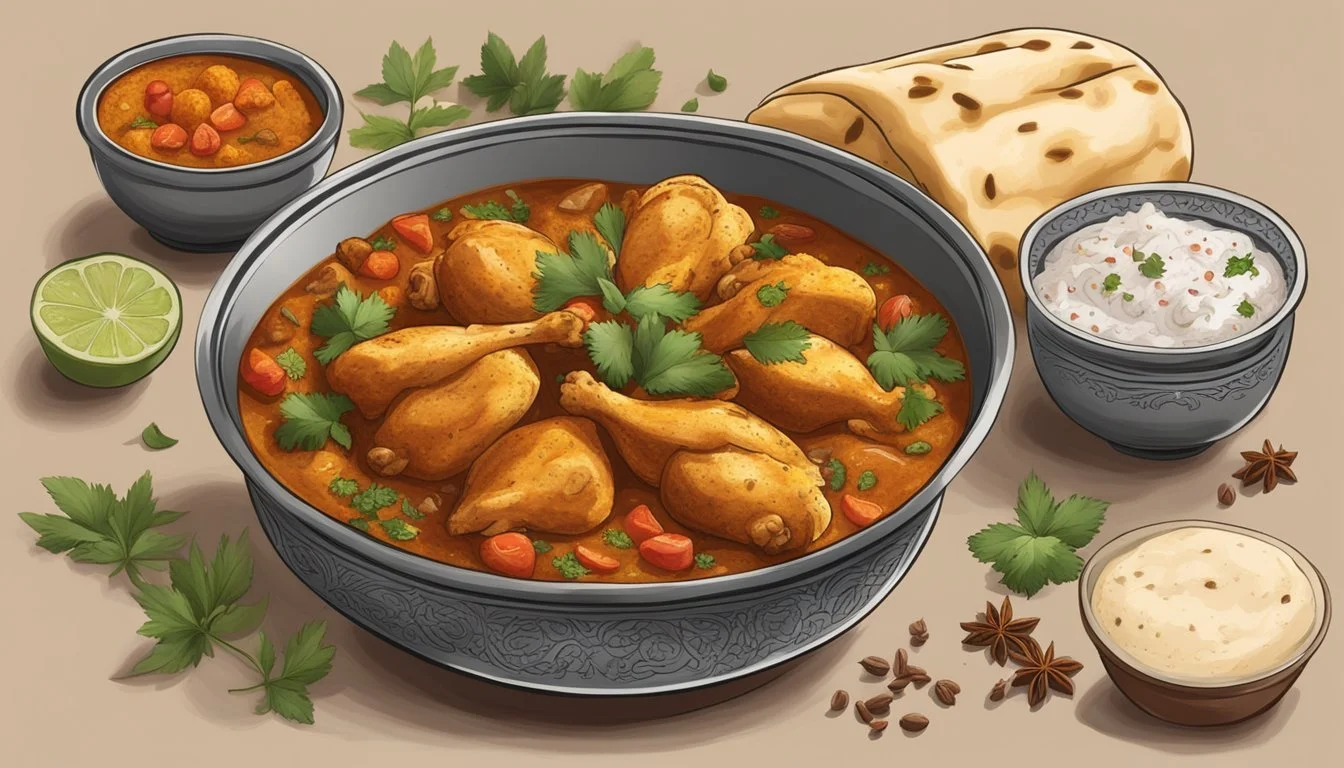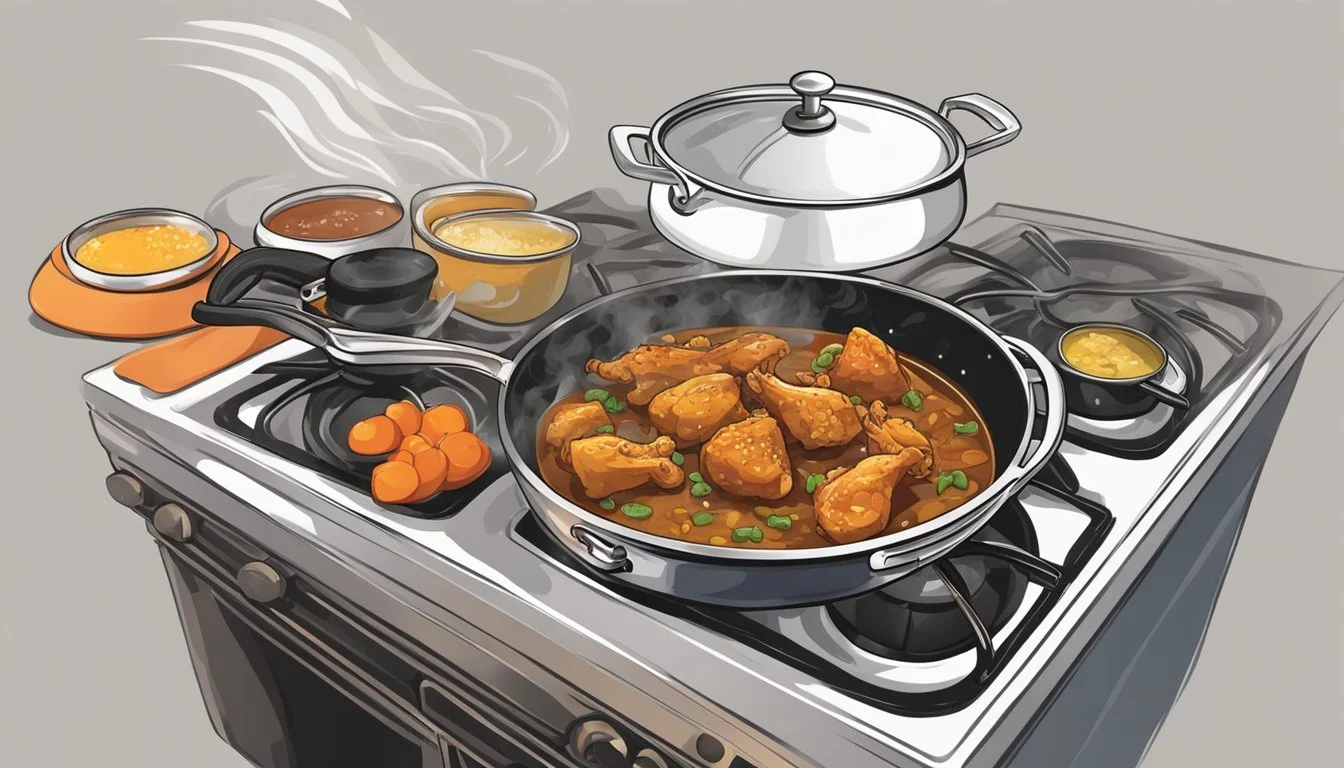How do you eat a chicken vindaloo?
Tips for Enjoying This Spicy Dish
Chicken Vindaloo (What wine goes well with chicken vindaloo?) is a prominent dish in Indian cuisine, known for its fiery heat and sharp tanginess. Originating from the Goa region, it carries with it the influences of over 400 years of Portuguese rule, merging local Indian flavors with cooking techniques introduced by the Portuguese. This vibrant curry represents a fusion of cultures, combining Portuguese style of meat marinating in wine and garlic with Indian spices and chili peppers.
The essence of a good Chicken Vindaloo lies in its balance of flavors – a harmonious blend of spicy, sour, and a hint of sweetness. Traditionally, the chicken is marinated in a mixture of vinegar and spices, allowing the flavors to penetrate the meat. The resulting dish is not only a testament to Goan cuisine but also to the adaptability and innovation found within regional Indian food (What wine goes well with Indian food?) practices.
When it comes to eating Chicken Vindaloo, it is typically served with a side of steamed rice or Indian bread like naan or roti, which helps to manage the spice levels. The rice or bread complements the robust flavors of the vindaloo sauce and makes for a satisfying meal, allowing the diner to experience the complexity of this storied dish. Its versatility also pairs well with an array of Indian side dishes, creating a well-rounded and deeply flavored culinary experience.
Understanding Chicken Vindaloo
Chicken Vindaloo is a vibrant curry that stands out in Indian cuisine for its bold flavors. It is characterized by a tangy and spicy profile, primarily thanks to the liberal use of vinegar and a variety of spices. A core ingredient in the dish is garlic, which imparts a robust aroma and depth to the curry. Vindaloo is traditionally made with protein, such as chicken, but variations include pork, lamb, beef, or even shrimp, catering to a range of dietary preferences.
Key Ingredient Role in Dish Vinegar Adds tanginess Garlic Enhances flavor Spices Provides heat Protein Main element of dish
Predominantly, chicken vindaloo utilizes a spice blend with Kashmiri chillies, cloves, cinnamon, and cumin. This amalgamation is ground with vinegar to create a paste—the marinade in which the chicken is soaked, infusing it with the essence of the dish.
The cooking process involves browning the chicken, which is then simmered in tomato sauce mixed with the prepared spice-vinegar blend. This combination creates a rich, deeply-flavored curry that is both spicy and tangy. The origins of vindaloo are traced back to Portuguese "carne de vinha d'alhos", a reference to its foundational ingredients of meat (carne), wine (vinha), and garlic (alhos). Over time, local adaptations led to the replacement of wine with local vinegar, and the integration of Indian spices, transforming it into the vindaloo known today.
Ingredients Breakdown
When preparing chicken vindaloo, each ingredient plays a vital role in creating the dish's complex flavor profile and nutritional value. An understanding of the components can enhance both the cooking and dining experience.
Proteins and Fat Choices
Chicken is the primary protein in chicken vindaloo, providing a lean source of protein as well as key nutrients like iron and vitamin B. Alternatives to chicken include pork, lamb, beef, or shrimp, offering variations in fat, calories, and texture. The cooking fat, often ghee or oil, contributes to the dish's richness and satiety factor.
Spices and Aromatics
The spice mix, including ingredients such as cumin, coriander seeds, mustard seeds, cardamom pods, garam masala, turmeric, cinnamon, and black pepper, infuses the vindaloo with intense flavors and potential health benefits. For example, turmeric is known for its anti-inflammatory properties, while cinnamon may help control blood sugar levels. Garlic, ginger, and cloves add depth to the aroma and flavor while also offering their own nutritional advantages, like vitamin C and fiber.
Vegetables and Acidity
Onions, such as red onions, and tomatoes, whether diced, pureed, or in paste form, are essential for the texture and acidity balance. They also contribute to the fiber, vitamin C, and vitamin A content of the dish. Potatoes can be added to thicken the sauce and provide a starchy component that complements the heat from the spices.
Additional Ingredients
Basmati rice often accompanies chicken vindaloo to provide a neutral flavor base and absorb the fiery sauce. It also adds to the nutrition facts by providing a source of energy and calories without adding fat. Vinegar, typically apple cider vinegar, is critical for the tanginess characteristic of the vindaloo, and sugar might be used to balance the heat and acidity. Salt enhances flavor and should be used with consideration to the sodium content.
Allergy and Diet Information
Those with dietary restrictions should note that chicken vindaloo can be adapted to be gluten-free. For individuals watching their calorie intake or concerned about nutrition facts, the amount of oil and type of protein used can be modified. Being rich in spices, the dish can potentially offer anti-inflammatory benefits and aid digestion due to the fiber from the vegetables. It is always advisable for those with allergies to review all the ingredients used in the spice mix to ensure they are not exposed to allergens.
Preparation and Cooking Techniques
Chicken vindaloo is an Indian dish that combines marinated protein with a richly spiced curry, cooked to tender perfection. The marinating process infuses depth of flavor, while cooking techniques ensure each bite is flavorful and satisfying.
Marinating the Protein
Before cooking, the chicken—often the protein of choice—should be thoroughly marinated to enhance its flavor. Key ingredients in the marinade include a blend of garlic, ginger, vinegar, and a tailored spice mix, which may consist of garam masala, cumin seeds, and curry paste. The chicken is typically mixed with this marinade and left to absorb the flavors for at least 30 minutes, though longer marination times of up to 8 hours in the refrigerator can intensify the taste.
Cooking the Vindaloo Curry
Once marination is complete, the marinated chicken is cooked using a high-heat oil such as ghee to seal in flavors. Onions are usually browned in the same pan before adding the protein to create a delicious base. Key spices are then added to the mix—often tomatoes, additional spice mix, and potatoes for body. Liquids such as water or chicken broth are introduced to create a curry sauce, with the entire concoction typically simmered in a covered pot or an Instant Pot for a time-efficient method. The goal is to reach tender, fully cooked chicken immersed in a thick, aromatic sauce.
Serving and Pairings
Properly served, chicken vindaloo shines as the focal dish accompanied by traditional staples. Basmati rice or flatbread such as naan can be served on the side to complement the vindaloo's bold flavors. Additional pairings may include a cool chutney to balance the heat, while a garnish of fresh cilantro (how long does cilantro last?) can provide a burst of color and freshness. For added variety, the vindaloo can also be enjoyed with other Indian side dishes or simple roasted vegetables.
Accompaniments and Side Dishes
When enjoying a flavorful dish like chicken vindaloo, selecting the right side dishes enhances the dining experience. Accompaniments should balance the heat with soothing flavors or textures, and offer variety across grains and vegetables.
Complementing with Breads
Naan: This traditional Indian flatbread serves as a perfect tool for scooping up the thick vindaloo sauce. Naan can also be flavored with ingredients like garlic or cilantro for an added aromatic touch.
Other Breads: For those who prefer gluten-free options, there are various gluten-free breads or flatbreads that can substitute for naan while still respecting dietary restrictions.
Rice Varieties and Preparations
Basmati Rice: Known for its fragrant aroma and long, slender grains, basmati rice is the quintessential pairing with chicken vindaloo. It can be simply boiled or steamed to provide a neutral counterpoint to the robust flavors of the curry.
Preparation Tips:
Rice can be enhanced by tempering with ghee and cumin seeds before cooking, imbuing it with a nutty flavor.
To further complement the vindaloo, rice may be garnished with freshly chopped cilantro leaves.
Vegetable Options
Onions: Often caramelized to bring out their natural sweetness, onions can be served as a topping or a side to counterbalance the spiciness of vindaloo.
Ginger: Incorporating ginger paste into vegetable dishes, such as sautéed greens or a simmered vegetable curry, adds a warming and palate-cleansing effect.
Assorted Vegetables:
Vegetables can be prepared as a simple stir-fry with spices to match the intensity of vindaloo.
A cooling cucumber salad with cilantro and a light dressing can provide a refreshing contrast.
Storage, Reheating, and Leftovers
Proper storage and reheating are crucial for maintaining the taste and safety of chicken vindaloo leftovers. This section provides specific instructions to ensure the dish remains delicious when served again.
Storing Chicken Vindaloo
To keep chicken vindaloo fresh, it should be stored in the refrigerator within two hours of cooking. Ideally, one should transfer the curry to an airtight glass container which helps to preserve flavors and prevents the curry from absorbing any odors. Properly stored, chicken vindaloo will last in the refrigerator for up to three to four days.
Best Reheating Practices
When it is time to reheat chicken vindaloo leftovers, ensuring that the curry's flavors remain robust is key. Microwave reheat may result in a loss of texture, so heating in a skillet or saucepan is preferable. To do so:
Place the vindaloo in a saucepan over medium heat.
Add a small amount of water or chicken broth to prevent drying out.
Stir occasionally, allowing the curry to heat evenly.
Ensure the inner temperature of the curry reaches 165°F.
One may also use an oven set to 350°F, covering the curry with foil to retain moisture. Heating times may vary, but typically it takes about 10 minutes for the dish to heat throughout.





